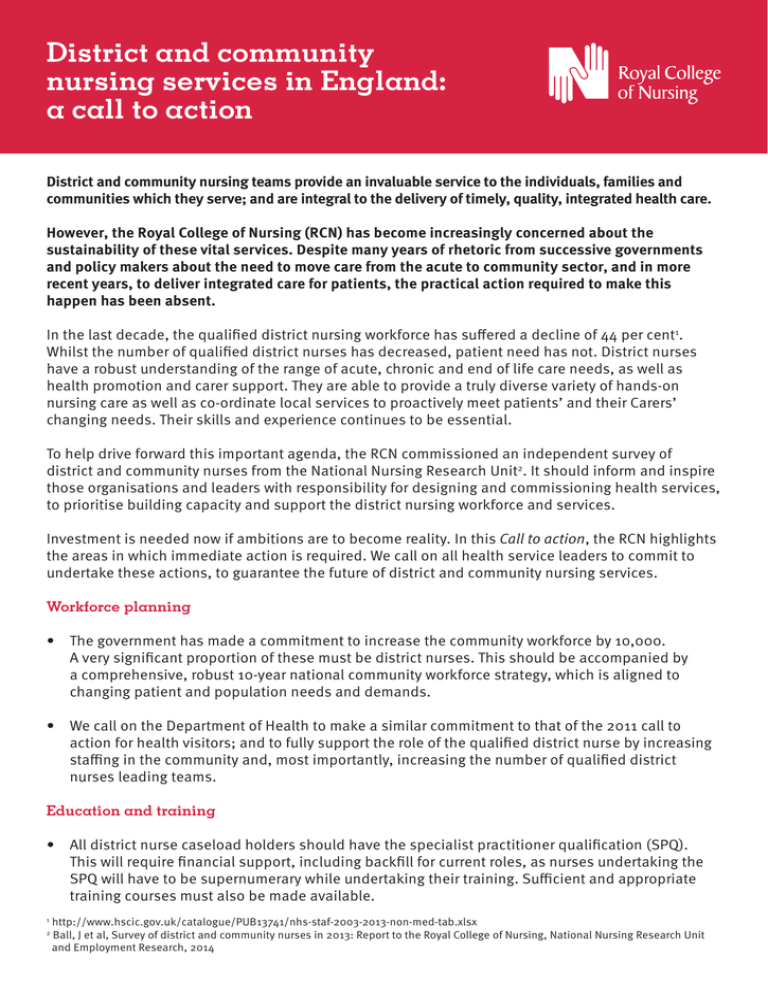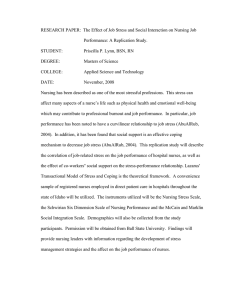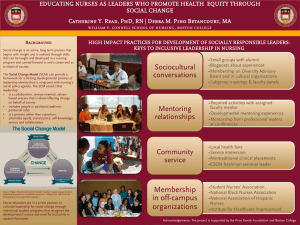District and community nursing services in England: a call to action
advertisement

District and community nursing services in England: a call to action District and community nursing teams provide an invaluable service to the individuals, families and communities which they serve; and are integral to the delivery of timely, quality, integrated health care. However, the Royal College of Nursing (RCN) has become increasingly concerned about the sustainability of these vital services. Despite many years of rhetoric from successive governments and policy makers about the need to move care from the acute to community sector, and in more recent years, to deliver integrated care for patients, the practical action required to make this happen has been absent. In the last decade, the qualified district nursing workforce has suffered a decline of 44 per cent1. Whilst the number of qualified district nurses has decreased, patient need has not. District nurses have a robust understanding of the range of acute, chronic and end of life care needs, as well as health promotion and carer support. They are able to provide a truly diverse variety of hands-on nursing care as well as co-ordinate local services to proactively meet patients’ and their Carers’ changing needs. Their skills and experience continues to be essential. To help drive forward this important agenda, the RCN commissioned an independent survey of district and community nurses from the National Nursing Research Unit2. It should inform and inspire those organisations and leaders with responsibility for designing and commissioning health services, to prioritise building capacity and support the district nursing workforce and services. Investment is needed now if ambitions are to become reality. In this Call to action, the RCN highlights the areas in which immediate action is required. We call on all health service leaders to commit to undertake these actions, to guarantee the future of district and community nursing services. Workforce planning • The government has made a commitment to increase the community workforce by 10,000. A very significant proportion of these must be district nurses. This should be accompanied by a comprehensive, robust 10-year national community workforce strategy, which is aligned to changing patient and population needs and demands. • We call on the Department of Health to make a similar commitment to that of the 2011 call to action for health visitors; and to fully support the role of the qualified district nurse by increasing staffing in the community and, most importantly, increasing the number of qualified district nurses leading teams. Education and training • All district nurse caseload holders should have the specialist practitioner qualification (SPQ). This will require financial support, including backfill for current roles, as nurses undertaking the SPQ will have to be supernumerary while undertaking their training. Sufficient and appropriate training courses must also be made available. 1 2 http://www.hscic.gov.uk/catalogue/PUB13741/nhs-staf-2003-2013-non-med-tab.xlsx Ball, J et al, Survey of district and community nurses in 2013: Report to the Royal College of Nursing, National Nursing Research Unit and Employment Research, 2014 • More placements for nursing students are required in the community covering health and social care settings. This must be supported with appropriate mentoring and supervision. • Practice educators and teachers should be available to support and prepare both present and future caseload holders to run caseloads. This is not only key to the development of district nurse skills and expertise but also to support placement learning for pre-registration nurses who are the future workforce for community nursing and general practice. Leadership and support • Effective clinical leadership is essential to support district nursing teams. There should be a senior district nurse/matron (with the support of practice educators) overseeing several district nurse caseload holders and their teams. • The challenges of more isolated working and practice must be recognised. As patients with significant health needs and demands are increasingly cared for outside hospital the nurses caring for them frequently have to make complex decisions about care and treatment; unlike in hospital, where advice and support is more closely available. • District nurses provide care and case management to support older, vulnerable and often isolated patients to live at home, and help join up services to meet their changing needs. Wider partnership working across care sectors and multi-disciplinary teams should support and improve hospital discharge planning and help identify those patients with greatest needs and chronic and long term conditions. Teams and caseloads • The composition of district and community nursing teams should be determined following a patient and population needs assessment. • There are very few workforce planning tools and urgent work is required to share current good practice where it exists and make such tools available across the country. The use of workforce planning tools alongside benchmark data should inform the appropriate size and skill mix of the district nursing team3,4. It is imperative that we move away from a task-based approach to care. • Increased administrative support is also essential for district and community nursing teams. Administrative requirements are not currently aligned with existing administrative support, with nurses spending time undertaking administrative tasks that could be performed by members of a support team. • Workforce planning therefore needs to cover the full skill mix requirements of a district and community nursing team, including health care support workers, assistant practitioners, community nurses, district nurses (with SPQ) and administrative support. • The National Institute for Health and Care Excellence (NICE) has been tasked to produce evidence-based safe staffing guidelines5. Work has already begun on guidance for adult wards in acute hospitals, maternity settings, and accident and emergency settings, and future work is proposed for community nursing care settings. The timeline for this work on community settings has not been confirmed but NICE should begin work on this as soon possible. http://www.qni.org.uk/docs/DN_Workforce_Literature_Review_Web.pdf http://www.qni.org.uk/docs/District_Nursing_Workforce_Planning_Report.pdf 5 http://www.nice.org.uk/guidance/safestaffing/SafeStaffingGuidelines.jsp 3 4 Improved career pathway • There should be a clearly defined career pathway for district and community nursing. This will help to improve the appeal of working in the community. Existing misconceptions (such as students having to work for two years in a hospital setting before moving to a job in the community) as well as false perceptions about the nature of community care nursing roles must be addressed. IT resources • It is important that the supply of hardware – which is generally reported as adequate – should be accompanied by strategies to ensure it is used effectively. Examples of good practice, where IT is enhancing mobile working, need to be shared via an effective forum for networking and learning dissemination. Nurses must be given appropriate training. The RCN represents nurses and nursing, promotes excellence in practice and shapes health policies. June 2014 www.rcn.org.uk Publication code 004 675



